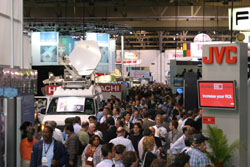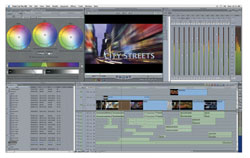At NAB2004 HD was in the air…but mostly on cable and satellite
Suddenly everyone in the production and broadcasting community is talking about high-definition television.

Attendance was up at this year's NAB2004. The NAB said the number of registered attendees this year was 97,544, up from 88,020 last year.
At the NAB convention in Las Vegas last week, the term that represents high-quality pictures and multichannel sounds was no longer a novelty but a central part of virtually every technical session and manufacturers’ marketing message. And for perhaps the first time, show attendees were listening.
Indeed, the HD gravy train that companies have been waiting for the past three years to boost their bottom line appears to have finally arrived at the station. Exhibit floor booths at the Las Vegas Convention Center were generally packed with eager professionals looking to buy equipment used to create and distribute HD content.
Attendees turn out in big numbers
The NAB said the number of registered attendees this year was 97,544, up from 88,020 last year. It was clear that this year the manufacturing industry is energized and confident that producing content in HD is on the minds of many.
There are several theories about the improved economic outlook and the change in attitude among potential customers. These include the competitive effect that the cable and satellite TV industries have had on HD distribution to manufacturers paying down their debt of the past few years (when R&D money was heavily invested in HD products that sat on the shelf), to broadcasters realizing increased ad revenue and freeing up capital spending budgets.
Get the TV Tech Newsletter
The professional video industry's #1 source for news, trends and product and tech information. Sign up below.
Many companies reported selling products on the show floor, something that hasn’t occurred with any significance for four or five years. “We see a real shift from professionals talking about HD to now acting on it and making the commitment necessary to make it happen,” said Sony President John Scarcella, alluding to Sony’s “Ride the HD Wave” message. “Sony is betting this is the watershed year for HD, and we feel confident that we are correct in our assumptions.”
Mobile companies on the move
National Mobile Television's HD4
The mobile production industry - which includes such companies as Colorado Studios, F&F Productions, National Mobile Television, NEP Supershooters, New Century Productions and Trio Video - is leading the way with HD, having built several new all-digital trucks to support HD production deals with ESPN, and more recently, FOX Sports. All have announced significant equipment deals with Ikegami, Sony and Thomson for HD cameras, switchers, video servers, and routers, and Chyron and Pinnacle Systems for graphics gear.
“NEP sees HD production exploding and these new trucks are a response to an increasing demand for full HD production, in both the 720p and 1080i formats," said George Hoover, senior vice president, operations engineering, NEP Supershooters.
At NAB, NEP Supershooters announced a deal with Thomson to buy new HD equipment to outfit a new HD truck to support a FOX Sports announcement that FOX will televise up to six NFL games in 720p HD this fall. This truck will be added to NEP’s existing three HD trucks that are supporting ESPN and the more than 200 live sporting events the all-sports network has produced 720p HD since the beginning of 2003. CBS and NBC have also both increased their HD production schedule, although they use the 1080i HD format.
Is HD bad for some businesses?
Not everyone is shouting the praises of this newfound HD interest. Those manufacturers that offer digital transmitters, such as Ai, Larcan, Harris, Rohde & Schwarz, and Thales Broadcast, were seen (and heard) at the show lamenting the fact that most of the roughly 1200 stations on-the-air in DTV are not distributing a high-power signal. To these companies' chagrin, most stations are operating at low-power to save on electricity costs. This has meant that the high-power transmission systems that cost millions of dollars, and bring in the most revenue for these companies, are still not being purchased as anticipated.
“The windfall that many transmitter manufacturers were expecting from DTV has not been realized to a large degree,” said one transmitter salesman who asked not to be identified. “We blame the FCC for allowing stations to comply with the DTV mandate while operating at low-power levels. It’s bad for business and it’s bad for the adoption of DTV among consumers. If these stations are operating at low-power, that means people on the fringes are not getting a signal. How good is that for the transition to DTV? If I’m a consumer and I can’t get a signal I’m not going to buy a digital set. I’m certainly not going to buy an antenna and put it on my roof.”
The HDV format
NAB2004 will also be remembered as the year that the new HDV format gained legitimacy among content producers and independent shooters and editors, as well as a large number of broadcasters who showed considerable interest in the new gear. Last year JVC was alone in announcing its JY-HD10U single-chip HDV camera and a small edit system capable of editing the long GOP 25Mb/s video it acquired.

Apple's Final Cut Pro HD
This year, JVC said it had sold more than 2000 of the cameras in the United States in the past eight months and showed a prototype 3-chip version that is better-suited (in terms of size and recording capacity) to broadcasters and production studio professionals.
Joining them this year was Sony, with its new HDV camera (still in prototype), and six editing systems that claim to support the format, including those from Adobe, Apple, Avid Technology, Canopus, Pinnacle Systems and Sony (Vegas).
“We’re opening the door of HD to everyone,” said JVC’s Dave Walton. “This [format] is something that’s needed because until now HD has been relegated to the elite. We’re not the only ones doing that this year, and that’s encouraging because it shows that the format has legs.”
Adding to the high-definition fever was Apple, which made a big HD splash at NAB2004 with the introduction of Final Cut Pro HD. In fact, Apple showed a complete HD editing system, including hardware, monitor and software. Panasonic aided in this announcement by introducing (at both its press conference and at Apple’s) the new AJ-1200A multi-format portable HD recorder.
HD puzzle pieces finally fitting together
This year it was clear that all of the missing pieces to the HD puzzle had been addressed. Rounding out the production chain was a variety of working products or systems demonstrated at the show; providing customers with many options and much needed competition to keep costs down. This included: real-time native editing (from Avid, Leitch, Quantel and Sony), graphics systems (from Adobe, Chryon, Discreet, Inscriber, Pinnacle Systems and Pixel Power); video servers (from Apple, Avid, Leitch, Omneon Video, Pinnacle, SeaChange International, Sony, and Thomson Grass Valley); production switchers (from Ross Video, Snell & Wilcox, Sony and Thomson Grass Valley); digital HD slo-motion camera systems (from Ikegami and Thomson); and a wireless HD camera system (Ikegami).
At NAB2004, the manufacturing community showed it was ready for HD production and distribution and that the technology is real. Likewise, attendees expressed their clear interest in moving to the next step in television production. This interest came from the broadcast and cable and satellite communities. Those stations upconverting their NTSC programming to standard-definition digital signals must have been left wondering where that leaves them.
The HD distribution train is up and running. Although many terrestrial stations are still not broadcasting HD, the cable and satellite industries have begun selling tickets for what is sure to be a financially satisfying ride. Some over-the-air broadcasters have joined them. Others are trying to find the right business model. At the show, a group of independent station groups, led by Emmis Communications, announced a new initiative that proposes that broadcasters combine their spectrum to create a low-cost, multichannel option to cable and satellite.
Jeff Smulyan, chairman/CEO of Emmis, said that by pooling digital spectrum and using the latest technology, broadcasters can provide the public with local channels in HD and at least 30 of the most popular cable networks in HD too.
“The television industry has allowed a third-party [cable and satellite] to take our product and profit from it,” he said. “If left unaddressed, this model will only further erode our business. However, technology has shifted, and we have the opportunity to strengthen our relationships [with consumers] and our businesses. It is time for us to take control of our industry and our destiny.”
The initiative - supported by many of the major station groups, such as Clear Channel, E.W. Scripps, Fisher Broadcasting, Media General, Meredith Corp., Raycom Media and Sunbelt Communications‚ is expected to cost subscribers $99 for a special set-top box and $25 per month in programming costs. There will be “limited” up-front costs to the broadcaster, the group said, and there was no word on when the new terrestrial service would be up and running. Smulyan said the broadcast industry has already spent $3.5 billion nationally for the digital buildout.
